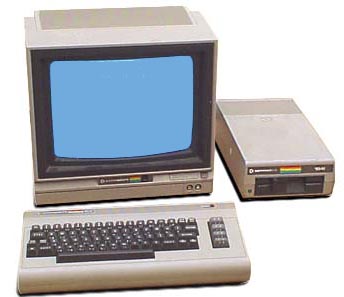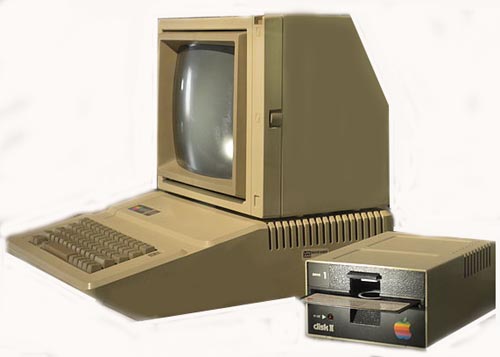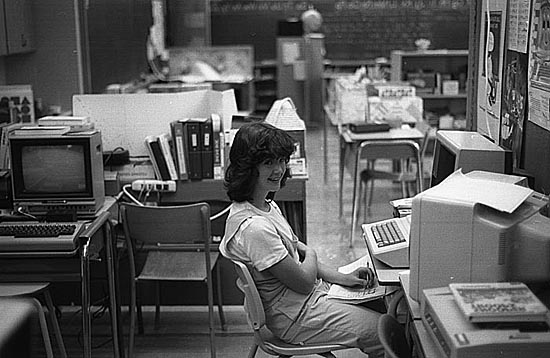


 |
 |
 |
|
Had the teachers who worked at the
Espanola Public School in the 1920s walked into the
school on the day A B Ellis closed its doors for the
last time, they would have found that in many ways
classrooms were fundamentally the same. There
were still desks and chairs and boards displaying the
work of the pupils. They would still find shelves
lined with books and shoes scattered below coats in
the cloakrooms. There were still blackboards,
although they would likely be perplexed as to what a
whiteboard or an interactive smart board was.
(below classrooms over the
decades)
In fact, you don’t need to go back to the 1920s.
I started work at the school in 1971 and it was well
into the 1990s before chalk was being replaced by felt
pens and whiteboards. However, this in itself
was not much of an advance. What was to become a
fundamental change was the introduction of computers
and associated digital devices that have altered
schools and all of our lives forever in a period of 30
years.  In the mid 1990s John Snobelen was appointed Minister of Education in Ontario at a time when the government of the province was at war with the teachers. He argued that he could foresee a time when pupils wouldn’t need teachers because they would do all of their learning in front of computers. Clearly, that hasn’t happened yet but in researching a high school in Copenhagen, in Denmark, one maths teacher was explaining how he had put all of his lessons online and he used his time in the classroom as a resource person to whom the students could turn should they have difficulty. I think I can claim that I played a role in introducing and promoting the use of computers at A. B Ellis or as some might see it, inflicting them on a somewhat reluctant clientele. What follows is my memory of how computers came to the school and how their use progressed between 1980 and 2000. Once again these are my memories and I apologize in advance for any mistakes or omissions that come from trying to cast my mind back that far. I was on sabbatical at a university in the UK during the 1981 - 82 school year and it was here that I first got my hands on a computer. In their library resource centre they had a Commodore PET computer and one of the projects I did involved writing a BASIC program for children to use to practice simple arithmetic skills.  When I returned to A B Ellis, it was at a time when some staff members were buying Commodore 64 computers for their homes. I had seen them at computer conferences but I didn’t have one. The original retail price of a C64 was $595US and it boasted 64Kb of RAM memory. Putting that in context photographs snapped on your mobile phone are usually in excess of 4 or 5MB. So the Commodore 64 was running a whole desktop computer with 64,000 bytes of memory and your phone casually used 5,000,000 bytes to take and store just one photograph.  However, don’t get me wrong I was impressed. My big day came when I found a Commodore 64 AND an Apple IIe in a random pile in the school’s workroom.  They had been funded by the Board for an investigation into which offered the most potential for learning and the teacher in charge had changed his mind about doing it. After a period of whining and pleading, I took over the project. These were the first two computers of their kind in the school and they ended up in the Special Ed department.  Towards the end of the 1980s things changed dramatically and that pace of change continued relentlessly. You need to keep in mind we were still a decade or so away from the introduction of mobile phones and the other hand-held devices that we take for granted now. The Ministry of Education in Ontario decided to do something about the integration of computers into the curriculum and sponsored the development of an appropriate computer. This became the ICON, nicknamed the Bionic Beaver. In form it resembled the old PET computers since it had an integrated monitor and keyboard. It also had a trackball that allowed the user to interface with the programs in a way that Apple’s mouse did. It was also a networked computer connected by co-axial cable to a central fileserver on which the software and the users files were stored. The Ministry introduced a grant system to help schools to buy computers that complied with the standards they set. These were described as Grant Eligible Microcomputer Systems or GEMS and in the beginning the only computer eligible for that money was the ICON. There was nothing to stop schools from buying other computers but the Ministry wasn’t going to assist in paying for them. So for a number of years the ICON dominated computing at A B Ellis. The whole school was wired with co-axial cable running to outlets in each room. The fileserver was located centrally and as they were acquired computers went into classrooms. These were still, for the most part, allocated one to a room and although the software was more educational it wasn’t immediately obvious to most teachers where to fit it in to their existing curriculum. In my mind the next step was the arrival in Espanola of a new Director of Education who, someone pointed out, had a computer on his desk. Once again that would be nothing unusual in 2016 but in those days it was RADICAL, and to put a fox among the chickens it was a Macintosh. What followed soon after was computers replacing typewriters in the school office at A B Ellis. This led to me working with Annie Rogerson to develop a database for her to use to enter all the students and their personal information, so that instead of her having to ask classroom teachers to collect information about their students, she could be a source of that information for them. Then we put a computer in the library and equipped it with appropriate software so that all of the library’s collection of books and other resources could be entered.  This made it possible for teachers and students to quickly search the library’s collection in relation to any interest they might have. A collection of volunteers were recruited to manually enter the data. The arrival of the Internet stimulated the next set of changes. Aware of the growing interest in the potential of the Internet, our next Director arranged for me to take some time away from my teaching duties to spend it surfing this “Internet thing” to see if it was of any value. I was doing this by connecting via a modem, that was a long long way from broadband, and before we had the graphical point and click interface that we all take for granted now. Sometimes today, if a website has a problem loading, you find to your surprise that there are no pictures just words. That is what the Internet was like with the equipment we had at that time. Soon after the School Board bought into a project that provided a direct connection to the Internet so we could abandon the use of modems to dial-up. Since I was the person pushing for these developments, the access point was located at A B Ellis so I could be responsible for looking after it and making the phone calls when it didn’t work.  This was huge bonus for A B Ellis because it meant that any computers attached to this router were directly on the Internet. So from its location in the Library, I set about running ethernet cables through the building, often accessing the space above suspended ceiling tiles and holes through walls that had been used by the ICON cables. The Director wanted to make sure that not only did the schools benefit from this Internet connection but also the wider community. So I invited people to a meeting who might like to use our Internet connection outside of school hours. A plan was devised which allowed people to book sessions connecting to our router from home via modem. It wasn’t possible for us to do this with any degree of sophistication so, if someone was allocated 9am until 11am on Saturday, it was understood they would get off to allow the next person to get on. It seemed to work fine, at least no one complained, mind you it was free. It was around this time that the school took advantage of a change in GEMS funding. The Ministry’s definition of which computers were eligible for funding had changed. No longer did the ICON hold centre stage and I opted to use the available money to purchase enough Macintosh computers to set up a computer lab, so that whole classes could be involved in actual computer based learning. Money was found to equip the old lunch room on the top floor of the 1971 extension with adequate electrical outlets and the High School gave us a collection of old typing tables that were surplus to their needs.   I found a way through the ceilings and crevices of the building to lay ethernet cable from the library to take the computers in the lab onto the Internet. Again this will seem beyond the belief of many of the younger generation but I was running after-school sessions for teachers trying to convince them that the Internet was something exciting and useful and may I add I often failed to convince them. Once we made the leap to get the school online we had to confront the issue of how much and which parts of the Internet were suitable for the students to access. In the lab I installed software that not only restricted access but allowed me as a teacher to watch what the individual students were doing on their computers. However, I was acutely aware that, although for many students this was their only opportunity to access computers and the Internet, for some they had much better equipment at home and some took issue with my decision to choose Apple computers. I was appointed as the school’s computer teacher first part-time circa 1997 and then full-time a year later and I worked with classroom teachers to assist them in the use of computers to fulfill aspects of their curriculum. We would plan units and I would teach classes in the lab. I also ran training sessions for teachers and ancillary staff. I was also asked to help other elementary schools and I often visited them to help install equipment and problem solve issues that occurred along the way. I also invited other schools to bring their students to use the lab and that invitation was taken up on a number of occasions. Having set that lab up, I gathered up all the ICONS that were by this time gathering dust in classrooms and used an empty classroom in the old building to create a lab of ICONS. They had some useful software and were of value for things like word processing and learning typing skills. This lab was unstaffed and just made available to whichever teachers wanted to use it. In many respects the room wasn’t needed and the computers weren’t being used so there wasn’t much to be lost be trying it as an experiment. However, with no computer teacher to assist, very few teachers used the facility, Appropriate software continued to be an issue, so the principal at the time purchased two packages of software one for the Primary Division and one for the Intermediate Division. Apart from the fact that this software had direct application to their curriculums, it also meant that it provided enough support that classroom teachers could feel secure taking charge. In the lab I was usually only needed if something went wrong. So when I left the school in 2000 it had 2 computer labs, computers in the office, a computer in the library and a smattering of individual computers around the school. We had reasonably fast Internet connections and even report card writing had gone electronic. We had come a log way from the Commodore PET but in the years after I left, technology and decisions about its use changed dramatically again, but that is for someone else to talk about. David Boardman |